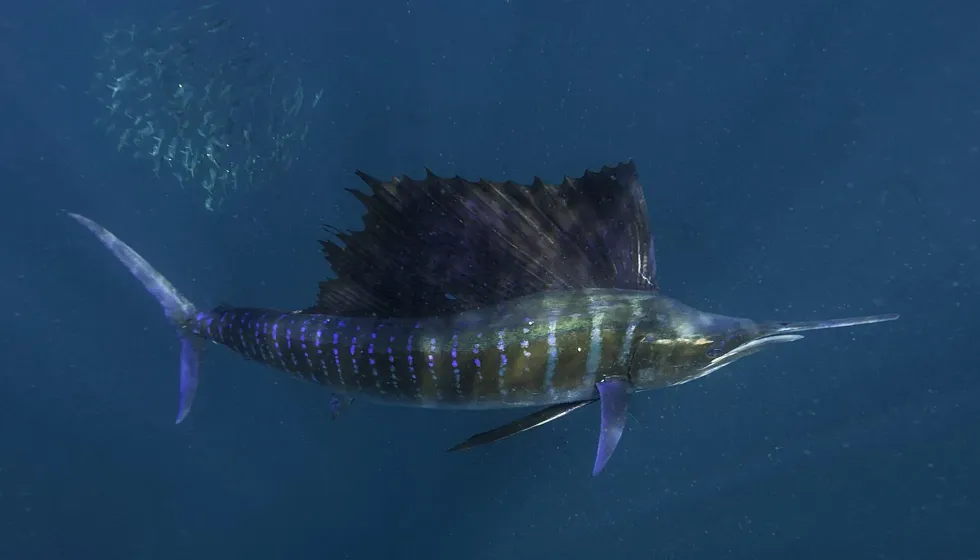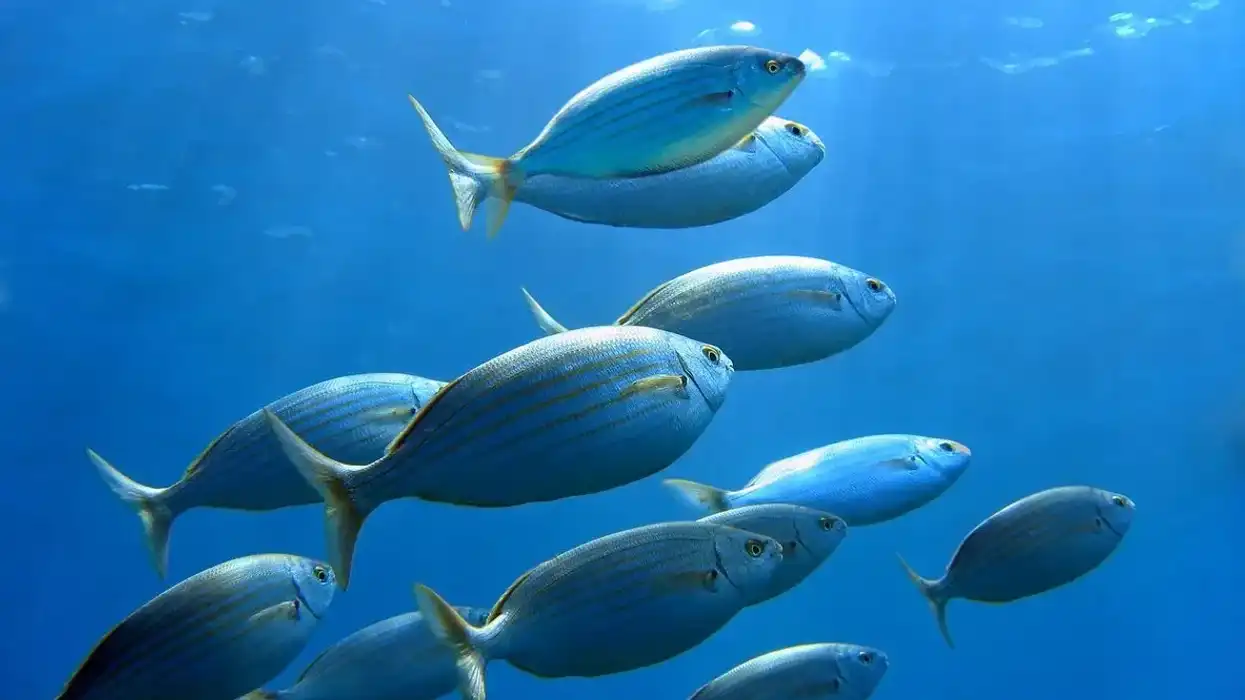The members of the Istiophoridae family, the sailfish is contemplated as the fastest moving fish, with the capability of launching itself in the air.
This is why the sailfish is tagged as the fastest fish in the sea. The sailfish of the genus Istiophorus is branched into two species with different geographical distributions: the Indo-Pacific sailfish (Istiophorus platypterus) and the Atlantic sailfish (Istiophorus albicans).
The Istiophorus platypterus inhabits the Atlantic Ocean and the Istiophorus platypterus inhabits the Pacific Ocean.
These fishes are labeled as sailfish because of the sail-like dorsal fin and their fins are generally down folded is when they attack their prey they raise their fins. Another crucial feature is that the length of their upper jaw is twice the length of their lower jaw.
The sailfish is a frequent target of the commercial fisheries and it is also a major game fish and targeted by recreational fishermen particularly by athletic teams like Palm Beach Atlantic Sailfish.
Already found this species of fish interesting? Then keep reading this article as more interesting facts about the Atlantic sailfish are stated below.
If you like this article, we have more such articles where we have curated intriguing facts about other animals like sailfish and Indo-Pacific sailfish that you can share with your children.
Atlantic Sailfish Interesting Facts
What type of animal is an Atlantic sailfish?
The extremely dirigible species of fish, discovered in the Atlantic Ocean is the Atlantic sailfish that can be recognized for its modified upper jaw, and two dorsal and anal fins.
What class of animal does an Atlantic sailfish belong to?
The Istiophorus albicans belong to the class of Actinopterygii, order Perciformes, sub-order Xiphioidei, family Istiophoridae and genus Istiophorus.
How many Atlantic sailfish are there in the world?
The actual number of Istiophorus albicans is not listed.
Where does an Atlantic sailfish live?
The range of geographical distribution of this sailfish expands across the Atlantic Ocean and this species of fish primarily swims near the surface of the ocean.
Their range is around 40 degrees North in the Northwest region of Atlantic to 40 degrees South in the South in the Southwest Atlantic, and 50 degrees North in the Northeast region of Atlantic to 32 degrees South in the Southeast Atlantic.
The Atlantic sailfish is contemplated as one of the extremely migratory and fastest fish and they predominantly migrate into the Mediterranean sea from the open ocean.
However, in the region of the western Atlantic, they can be found a substantial amount near the Caribbean Sea, the Gulf of Mexico, and Florida.
What is an Atlantic sailfish's habitat?
These sailfish inhabit the upper and warmer layer of the ocean, this species can also be spotted close to the shore. These fish are capable of diving deep into the ocean, however, the ideal temperature for them is 70-82 F (21-28 C).
Who do Atlantic sailfish live with?
No much has been documented esteeming the behavioral pattern of these sailfish. Nonetheless, the sailfish can be observed swimming in small groups or even alone when they are adults, while juveniles can be observed in bigger schools.
How long does an Atlantic sailfish live?
The average lifespan of the Atlantic sailfish is approximately 16 years.
How do they reproduce?
Once the Atlantic sailfish attains sexual maturity, they are ready for spawning. The breeding season is primarily the summer months, and it commences in April and the spawning region of this species is southeastern Florida.
Females can be detected swimming near the surface as their dorsal fin is visible.
The female is frequently accompanied by one or male species and the spawning occurs closer to the surface of the sea, however, spawning may take place even in the deep offshore water along the North American coast and the continental edge off the coast of West Africa.
Spawning can be detected in the eastern Atlantic all year long particularly during summer. The fertilization occurs externally as the female releases 4,500,000 eggs and it takes 36 hours for the eggs to hatch.
What is their conservation status?
The Atlantic sailfish and the Pacific sailfish (Istiophorus platypterus) are amongst the most sought-after marine species of the Atlantic and Indo-Pacific Oceans. The Istiophorus Albicans and Istiophorus Albicans possess modified upper jaw and distinguish fins that are widely caught by commercial fisheries and recreational fishermen.
However, the conservation status is not listed by IUCN, hence we can not tell for sure if they are endangered or not.
Atlantic Sailfish Fun Facts
What do Atlantic sailfish look like?
The Istiphorus albicans and Istiphorus platypterus are the species of sailfish, their range of distribution covers the Atlantic and the Pacific Ocean, respectively.
These fishes are related to the barracuda and swordfish other than the marlins. The Atlantic sailfish can grow very rapidly and can reach a maximum body length of 124 in (315 cm) and their weight is around 128 lb (58 kg) although it is considered as one of the smaller species of family Istiophoridae.
The body of the Atlantic sailfish is covered in scales and the dorsal color of these fish are dark blue and white, while the ventral region is covered in brown spots.
There are over 20 bars (vertical) on each side of their body which consists of numerous light blue dots.
They have an enhanced upper jaw adapted into a long bill and the length is twice the length of their lower jaw. The sail-like dorsal fin is the justification of its name and is primarily raised during preying.
There are two dorsal and anal fins, and the dorsal fin has many black dots, their fins are commonly blackish-blue while the underside of the anal fin is white.

How cute are they?
The Atlantic sailfish is not a cute marine fish and can appear intimidating because of its modified jaw and fins.
How do they communicate?
There is not much data about the communication skill of this species, however, adult fish are frequently spotted in small groups.
How big is an Atlantic sailfish?
The maximum length an Atlantic sailfish can attain is 124 in (315 cm), yet is considered amongst the smaller fishes of the Istiophoridae family as the other members of the family like black marlin can grow as big as 181 in (460 cm).
How fast can an Atlantic sailfish move?
The species of sailfish is deemed the fastest moving marine fish and can achieve a speed of 22 mph (36 kph).
How much does an Atlantic sailfish weigh?
These sailfish can grow very rapidly and females are considerably larger than males and have more body weight and length. However, the weight of Atlantic sailfish is around 128 lb (58 kg).
What are the male and female names of the species?
There is no separate name for the male and female of the species.
What would you call a baby Atlantic sailfish?
It takes approximately three days for the eggs to hatch and the term ‘fry’ is assigned for most of the species of fish, but the exact name for the baby Atlantic sailfish is not listed.
What do they eat?
The Atlantic sailfish is a major predator and prey primarily on tiny fishes like tuna, needlefish, ballyhoo, mullet, squid, and other marine fishes. As the Atlantic sailfish is a migratory fish it can be often seen near the surface of tropical waters in search of its prey.
They require a habitat where the water is warm and has abundant prey.
Are they edible?
Yes, these Atlantic fish are entirely edible. These fish are the target of commercial fishing and recreational fishing and their smoked meat is widely consumed.
Would they make a good pet?
No, they cannot make a good pet because they are huge and it is practically impossible to keep them in an aquarium. They survive best in their natural habitat.
Did you know...
An Atlantic sailfish jumping is a common phenomenon that can be frequently caught sight of in the ocean.
The sailfish possess the ability to alter its body color to light blue with yellow streaks and the entire process is administered by its nervous system.
What size is a trophy Atlantic sailfish?
The Atlantic sailfish can develop very rapidly, particularly the female fish, as they are sexually dimorphic. Females are larger than the male.
Sailfish are game and are the victim of recreational fishing and the size of the fish is significant in recreational fishing. The size of a trophy Atlantic sailfish must exceed 90 in (229 cm) and weigh more than 80 lb (36 kg).
Is the Atlantic sailfish a state fish?
Yes, the Atlantic sailfish is the official state saltwater fish of Florida and the legislature of Florida approved this fish in 1975.
Here at Kidadl, we have carefully created lots of interesting family-friendly animal facts for everyone to discover! For more relatable content, check out these swai fish facts and skate fish facts pages.
You can even occupy yourself at home by coloring in one of our free printable Atlantic sailfish coloring pages.










